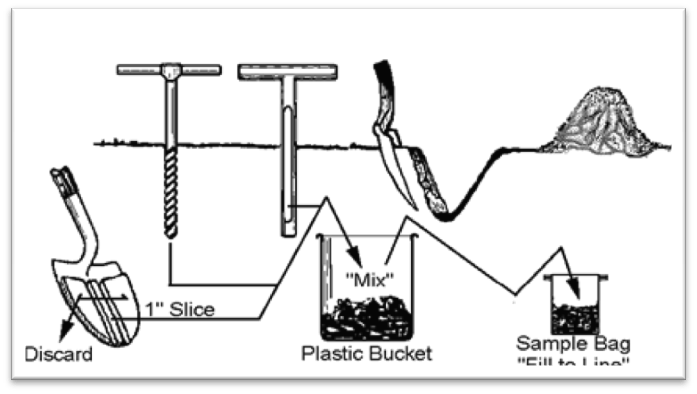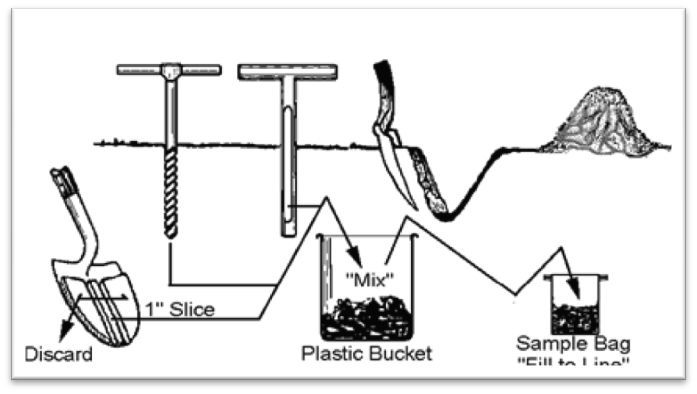Total Exchange Capacity (TEC):
Measures the capacity of the soil to hold nutrients. The higher the TEC reading, the greater the capacity. Peat or muck soils will have TEC’s in excess of 35, heavy clay type soils have TEC’s ranging from 15 to 35, loamy soils from 6 to 15, and sandy soils are often below 6. Although high TEC soils can hold more nutrients, it does not necessarily imply that they are more productive. Much depends on good soil management (such as drainage, tillage, nutrient ratios, etc…).
Soil pH:
Total exchange capacity is expressed in milliequivalents per 100 grams of soil. To determine this soil cations, such as calcium, magnesium, hydrogen, potassium, and sodium are expressed in terms of their relative ability to displace other cations. The unit, ME/100 g serves this purpose.
Buffer pH:
This measurement is an index value used for determining the amount of lime to apply on acid soils with a pH of less than 7.0. A value of “NA” is given on soils with water pH’s greater than 7.0.
Organic Matter:
Measures the amount of plant and animal residues in the soil after initial decomposition. The color of the soil is often closely related to the organic matter content. Light colored soils generally have 1 to 3.5% organic matter, while dark colored soils often range from 3.5 to 7.0% or higher. The organic matter serves as a reserve for many essential nutrients, especially nitrogen. During the growing season, a part of this reserve nitrogen is made available to the plant through soil microbial activity.
Estimated Nitrogen Release:
This is a calculation estimating the amount of potential nitrogen to be released in a growing season to the plants. The calculation is based off of the organic matter content of the soil.
Soluble Sulfur:
The soil test measures several forms of sulfur that can be readily available. Higher sulfur levels can occur when soils have reduced internal drainage, high soil pH, or are irrigated with water that his naturally high in sulfur. Optimum levels of sulfur in soil often depend on soil organic matter level content, soil texture, drainage, and yield goal. Generally, whenever the following conditions exist, the need for sulfur will be increasingly important for optimum plant growth:
- Well drained, low TEC soils
- Soils low in organic matter
- Low soil pH (below 6.0)
- Use of high analysis, low sulfur fertilizers
- High application rates of nitrogen fertilizers
- High sulfur demand crops
Overall the effectiveness of sulfur fertilizers is related to how fast the product becomes water soluble in the soil so that it is available for plant uptake.
Phosphorus:
We offer several different phosphorus tests. The most common is the Mehlich 3, which is included on all our standard packages. It gives an estimate on the amount of plant available P in the soil. Ideal levels are around 30 to 35 ppm, but may be higher for specialty crops, fruits, and vegetables. The Bray II phosphorus test is included on some reports too. The Bray II also measures plant available phosphorus, but it is a little stronger extraction and estimates some of the active reserve phosphorus in the soil (the portion that would become plant available once the plant available pool is used up by actively growing plants). A level of 40 to 60 ppm is good for most crops. Other P tests are available, but most are related to specific soil conditions/situations. These values in ppm can be multiplied by 4.58 to change units into pounds per acre of P2O5, which may make fertilizer recommendations easier.
Exchangeable Cations (Calcium, Magnesium, Potassium, and Sodium):
The amount of cations found on soil exchange sites (TEC). Levels of each nutrient vary between crops, soil types, soil textures, etc…
Base Saturation Percent:
Percent saturation refers to the proportion of the TEC occupied by a given cation (an ion with a positive charge such as potassium, sodium, calcium, magnesium, and hydrogen). The percentage saturation for each of the following cations for optimum crop performance will usually be within the following ranges:
- Potassium: 2 to 5%
- Magnesium: 12 to 18%
- Calcium: 65 to 75%
- Hydrogen: 0 to 12%
- Sodium: Less than 1% and/or less than the % potassium





